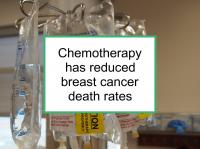A new study performed by the Early Breast Cancer Trialists’ Collaborative Group has reported that modern taxane plus anthracycline-based chemotherapy regimens and higher cumulative dose anthracycline-based regimens have reduced breast cancer mortality by approximately one-third, on average, compared to no chemotherapy.
The analysis of this data was designed to investigate the efficacy of several types of polychemotherapy regimens used to treat non-metastatic breast cancer after surgery. Polychemotherapy refers to the simultaneous administration of more than one chemotherapy drug. Modest differences in the effectiveness of chemotherapy regimens are plausible, and might influence treatment choices.
To conduct the study, the authors analyzed combined data from meta-analyses of randomized trials comparing the following regimens: (1) taxane plus anthracycline-based regimens compared to the same, or more, non-taxane based chemotherapy (44,000 participants); (2) one anthracycline-based regimen compared to another anthracycline-based regimen (7,000) or compared to cyclophosphamide, methotrexate, and fluorouracil (CMF) (18,000 participants); and (3) chemotherapy compared to no chemotherapy (32,000 participants). The scheduled dosages of cyclophosphamide, methotrexate, and fluorouracil, as well as of the anthracyclines doxorubicin, A and epirubicin (E) were used to define standard CMF, standard 4AC, and CAF and CEF.
The authors came to the following conclusions concerning specific chemotherapy regimens:
- Breast cancer-specific mortality was found to be reduced in trials that extended treatment duration by adding four separate cycles of a taxane to a fixed anthracycline-based control regimen. No significance difference was found in trials with four such extra cycles of a taxane compared to controls who were given extra cycles of other cytotoxic drugs (roughly doubling non-taxane dosage)
- Standard 4AC and standard CMF were equivalent in efficacy. However, anthracycline-based chemotherapy with substantially higher cumulative dosage than standard 4AC (e.g., CAF or CEF) was found to be superior to standard CMF
- Trials that compared chemotherapy to no chemotherapy found a trend toward greater mortality reductions with CAF than with standard 4AC or standard CMF.
Ten-year overall mortality differences (which included death from any cause, not just breast cancer) paralleled breast cancer-specific mortality differences, despite the potential toxic side effects of taxanes, anthracyclines, and other agents. Some modern taxane plus anthracycline-based regimens and higher cumulative dose anthracycline-based regimens (not requiring stem cells) reduced breast cancer mortality by approximately one-third, on average, compared to no chemotherapy. The authors note that information was lacking about tumor gene expression markers or quantitative immunohistochemistry, which might help to predict risk, chemosensitivity, or both.
The authors comment that breast cancer mortality reduction depends on absolute risks without chemotherapy (which, for ER+ disease, are the risks remaining after taking into account appropriate endocrine therapy). The risk of death after a diagnosis of ER+ disease can be reduced substantially by five years of endocrine treatment (aromatase inhibitor and/or tamoxifen), which is less toxic than chemotherapy. However, according to the study results, chemotherapy plus anti-estrogen treatment was superior to anti-estrogen therapy alone for ER+ disease.
In a separate interview, Richard Peto, one of the leaders of the Early Breast Cancer Trialists’ Collaborative Group, said, “Most breast cancers are ER positive, and for ER positive disease that appears to have been completely removed by surgery, the 10-year risk of recurrence and death from breast cancer can be reduced by at least half by giving a combination of a few months of modern chemotherapy plus five years of endocrine therapy.”
